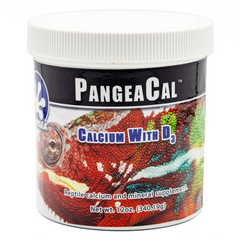Your Cart is Empty
Menu
-
- Live Animals
- Nutrition
- Habitats
- Habitat Supplies
- Light & Heat
- Humidity
- Husbandry
- Merch
-
- Contact Us
- Info
- Blog
- Professionals Login
- Gift Cards
- Login

0
Your Cart is Empty

Your Cart is Empty
May 01, 2019 3 min read
The Pangea Gecko Diets are all formulated with optimum levels of calcium and vitamin D3 for healthy growth and bone development. Only egg-laying females should have extra calcium added to their diet. Geckos that are not laying eggs should not need extra calcium added to their Pangea foods, this includes males and juveniles. If you offer insects to your geckos, it is still necessary to lightly dust those insects with a calcium and D3 supplement. For dusting insects, we recommend PangeaCal with D3, which is ideal for crested geckos and other related geckos being kept indoors without UVB lighting. For reptiles being kept under reptile specific UVB lights, we recommend Pangea Cal without D3, because those animals will already be receiving UVB helping them synthesize Vitamin D3 for calcium metabolitization.
Breeding female crested geckos have a higher demand for calcium than males or immature geckos. Some females may require additional supplementation with calcium in the food. We do not include this higher level of calcium in the foods because the calcium can actually interfere
 with the absorption of other essential nutrients. High levels of calcium can block the absorption of nutrients both directly and indirectly. The direct blocking action is the result of the calcium just getting in the way of the other nutrients and not allowing them to be assimilated in the gut. The indirect blocking is caused by calcium affecting the pH level of the gut. High calcium levels will raise gut pH, essentially neutralizing digestive acids, which makes the breakdown of other nutrients less efficient or nonexistent.
with the absorption of other essential nutrients. High levels of calcium can block the absorption of nutrients both directly and indirectly. The direct blocking action is the result of the calcium just getting in the way of the other nutrients and not allowing them to be assimilated in the gut. The indirect blocking is caused by calcium affecting the pH level of the gut. High calcium levels will raise gut pH, essentially neutralizing digestive acids, which makes the breakdown of other nutrients less efficient or nonexistent.
For female crested geckos that require more calcium in their diet, you can do a calcium power feeding once a week. This way it is only one of their feedings that are potentially blocking other nutrients while at the same time replenishing the bodies calcium. You can add 2-4% calcium to the dry diet once per week with no ill effects. This should be calcium with NO D3, as there is already plenty of D3 in the Pangea Gecko Diet. If you house a male with the female(s) you do not need to remove him during the calcium feeding as it will not hurt him.
that are potentially blocking other nutrients while at the same time replenishing the bodies calcium. You can add 2-4% calcium to the dry diet once per week with no ill effects. This should be calcium with NO D3, as there is already plenty of D3 in the Pangea Gecko Diet. If you house a male with the female(s) you do not need to remove him during the calcium feeding as it will not hurt him.
Many people free feed calcium by placing a dish of plain calcium in the enclosure from which the geckos can lick at will. This is a safe practice provided your geckos are healthy, hydrated, and not severely deficient in calcium. Start with just a tiny bit of calcium in the dish so that your geckos don't gorge on it. After a week or two, you can place more calcium in the dish and continue to keep it filled. Dump out and replace calcium every week or two or as it gets soiled.
If your geckos are laying eggs with snowflake pattern in the shell or severely under-calcified areas are showing up in the eggs, you should begin the once per week calcium power feeding. You can also monitor your female's calcium stores by examining the calcium sacs in the roof of the mouth.
Over Supplementation of Calcium
Although rare, it is possible to supplement with too much calcium. This generally happens when extra calcium is added to the diet too often. Geckos that receive too much calcium can begin to exhibit symptoms that look very much like a calcium deficiency. Symptoms generally begin with a wavy tail and can progress from there. If your gecko is on a complete diet and begins to show signs of calcium deficiency or MBD there is a possibility that too much calcium in the diet is the cause. If calcium sacs are full, the jaw is not rubbery, and radiographs show good bone density then too much calcium should be considered a possibility.
Related Articles